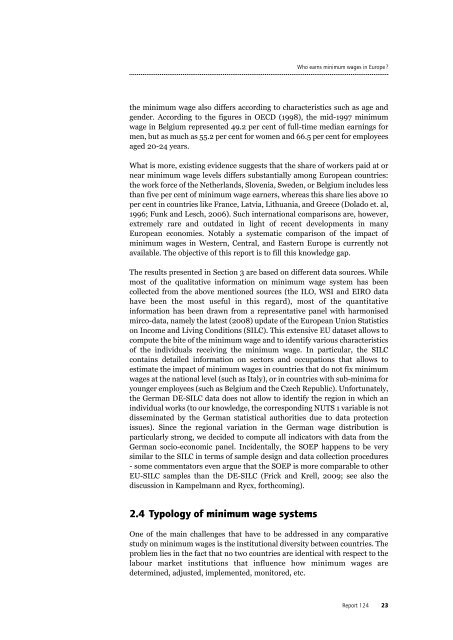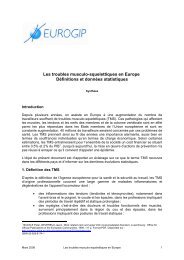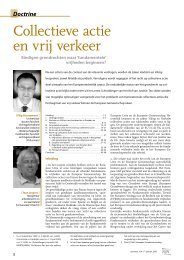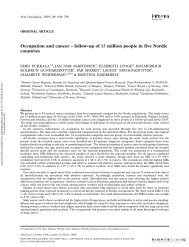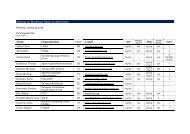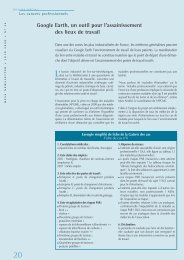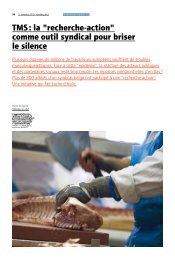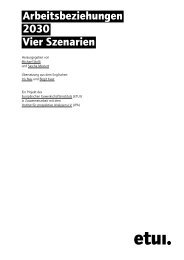Who earns minimum wages in Europe - European Trade Union ...
Who earns minimum wages in Europe - European Trade Union ...
Who earns minimum wages in Europe - European Trade Union ...
Create successful ePaper yourself
Turn your PDF publications into a flip-book with our unique Google optimized e-Paper software.
the <strong>m<strong>in</strong>imum</strong> wage also differs accord<strong>in</strong>g to characteristics such as age and<br />
gender. Accord<strong>in</strong>g to the figures <strong>in</strong> OECD (1998), the mid-1997 <strong>m<strong>in</strong>imum</strong><br />
wage <strong>in</strong> Belgium represented 49.2 per cent of full-time median earn<strong>in</strong>gs for<br />
men, but as much as 55.2 per cent for women and 66.5 per cent for employees<br />
aged 20-24 years.<br />
What is more, exist<strong>in</strong>g evidence suggests that the share of workers paid at or<br />
near <strong>m<strong>in</strong>imum</strong> wage levels differs substantially among <strong>Europe</strong>an countries:<br />
the work force of the Netherlands, Slovenia, Sweden, or Belgium <strong>in</strong>cludes less<br />
than five per cent of <strong>m<strong>in</strong>imum</strong> wage earners, whereas this share lies above 10<br />
per cent <strong>in</strong> countries like France, Latvia, Lithuania, and Greece (Dolado et. al,<br />
1996; Funk and Lesch, 2006). Such <strong>in</strong>ternational comparisons are, however,<br />
extremely rare and outdated <strong>in</strong> light of recent developments <strong>in</strong> many<br />
<strong>Europe</strong>an economies. Notably a systematic comparison of the impact of<br />
<strong>m<strong>in</strong>imum</strong> <strong>wages</strong> <strong>in</strong> Western, Central, and Eastern <strong>Europe</strong> is currently not<br />
available. The objective of this report is to fill this knowledge gap.<br />
The results presented <strong>in</strong> Section 3 are based on different data sources. While<br />
most of the qualitative <strong>in</strong>formation on <strong>m<strong>in</strong>imum</strong> wage system has been<br />
collected from the above mentioned sources (the ILO, WSI and EIRO data<br />
have been the most useful <strong>in</strong> this regard), most of the quantitative<br />
<strong>in</strong>formation has been drawn from a representative panel with harmonised<br />
mirco-data, namely the latest (2008) update of the <strong>Europe</strong>an <strong>Union</strong> Statistics<br />
on Income and Liv<strong>in</strong>g Conditions (SILC). This extensive EU dataset allows to<br />
compute the bite of the <strong>m<strong>in</strong>imum</strong> wage and to identify various characteristics<br />
of the <strong>in</strong>dividuals receiv<strong>in</strong>g the <strong>m<strong>in</strong>imum</strong> wage. In particular, the SILC<br />
conta<strong>in</strong>s detailed <strong>in</strong>formation on sectors and occupations that allows to<br />
estimate the impact of <strong>m<strong>in</strong>imum</strong> <strong>wages</strong> <strong>in</strong> countries that do not fix <strong>m<strong>in</strong>imum</strong><br />
<strong>wages</strong> at the national level (such as Italy), or <strong>in</strong> countries with sub-m<strong>in</strong>ima for<br />
younger employees (such as Belgium and the Czech Republic). Unfortunately,<br />
the German DE-SILC data does not allow to identify the region <strong>in</strong> which an<br />
<strong>in</strong>dividual works (to our knowledge, the correspond<strong>in</strong>g NUTS 1 variable is not<br />
dissem<strong>in</strong>ated by the German statistical authorities due to data protection<br />
issues). S<strong>in</strong>ce the regional variation <strong>in</strong> the German wage distribution is<br />
particularly strong, we decided to compute all <strong>in</strong>dicators with data from the<br />
German socio-economic panel. Incidentally, the SOEP happens to be very<br />
similar to the SILC <strong>in</strong> terms of sample design and data collection procedures<br />
- some commentators even argue that the SOEP is more comparable to other<br />
EU-SILC samples than the DE-SILC (Frick and Krell, 2009; see also the<br />
discussion <strong>in</strong> Kampelmann and Rycx, forthcom<strong>in</strong>g).<br />
2.4 Typology of <strong>m<strong>in</strong>imum</strong> wage systems<br />
<strong>Who</strong> <strong>earns</strong> <strong>m<strong>in</strong>imum</strong> <strong>wages</strong> <strong>in</strong> <strong>Europe</strong> ?<br />
One of the ma<strong>in</strong> challenges that have to be addressed <strong>in</strong> any comparative<br />
study on <strong>m<strong>in</strong>imum</strong> <strong>wages</strong> is the <strong>in</strong>stitutional diversity between countries. The<br />
problem lies <strong>in</strong> the fact that no two countries are identical with respect to the<br />
labour market <strong>in</strong>stitutions that <strong>in</strong>fluence how <strong>m<strong>in</strong>imum</strong> <strong>wages</strong> are<br />
determ<strong>in</strong>ed, adjusted, implemented, monitored, etc.<br />
Report 124<br />
23


